| Published
on 6
Nov
2013 |
All rights reserved.
|
|
|
For most of the time
during its 60 years history, Chevrolet Corvette was America's sole pure
sports car. To this date it is still the only mass production sports
car produced by Detroit, one that keeps American fighting with European
imports like Porsche, Lotus, Jaguar etc. You can see how important it
is in the heart of every American car lover.
Like the rest of the American auto industry, the Vette has undergone a
long decline since the 1980s but it is now bouncing back. The
outgoing ZR1 was a good sign that there is still life in the
Vette if GM commits to it. The new 7th generation Corvette is even more
promising. With brand new styling, new engine and new chassis, the C7
is a
big departure from the outgoing C6, which was a mild evolution from C5.
In terms of styling, it could be even the most
radical Corvette since the 1963 C2. No wonder it reuses the legendary
nickname
"Stingray".
Since the 1984 C4, Corvette has never altered its styling much. Its
general profile, its trademark wraparound rear window and quad-round
taillights have been serving the car for nearly 30 years. Now all have
gone. The C7 has a far more aggressive profile – a more flowing bonnet,
muscular front and rear fenders, coke-bottle sides and a high-rising
tail topped by a spoiler. A shark wide mouth opens at higher level than
before, beneath which is a body-integrated lip spoiler. The nose is so
clean and pure as it gets rid of signal lamps and fog lamps, which have
been incorporated into the HID and LED headlights. The bonnet has
deeper concaves and a more pronounced power dome with louvered
ventilation, so it looks more dramatic. The polygonal taillights look
more
Camaro than Vette, but the centrally-mounted quad-exhaust are
definitely spectacular. Sharp crease lines on the fenders and door
sills add aggressiveness that missed out in the last 3 generations.
Cooling has also taken a more important role. The hot air vents aft of
the front wheels are visually enhanced. Louvered intakes are added to
the top of rear fenders, drawing cold air to the oil cooler of rear
transaxle. The resultant hot air exits from the outlets incorporated
with the taillights. All were done with style.
Some may be disappointed that the C7 has lost its trademark feature –
the wraparound rear glass screen has been
replaced with conventional C-pillars and quarter windows. This also
hampers its rearward visibility by a considerable degree. That said,
the C7 is still significantly more striking to look than either its
predecessors or most of its European counterparts. Most important, it
is still unmistakably a Corvette!
The new LT1 small-block V8 keeps a displacement of 6.2 liters as well
as outdated pushrod OHV 2-valve construction, but it is actually a
clean-sheet design. It features variable cam phasing on its sole
camshaft to advance and retard intake and exhaust valves in a
continuous manner. Direct injection is another important new feature to
save fuel, ditto the introduction of cylinder deactivation technology
called Active Fuel Management or AFM, which switches the engine to V4
mode under light load. The LT1 produces a maximum 460 horsepower and
465 pound-foot
of torque, compared to 430 hp and 424 lbft of the outgoing LS3. Its
maximum rev is 6600 rpm, not bad for a pushrodder. Low to
mid-range torque gets a more noticeable increase. From 2000 to 3500 rpm
it produces an additional 50 lbft. Meanwhile, EPA-certified fuel
economy
is improved to 17 mpg city and 29 mpg highway – the latter is the best
among performance cars with the north side of 450 hp.
There are two choices of transmission: the manual is a new
Tremec 7-speed gearbox (it is the only 7-speed manual in the world
beside the ZF unit of Porsche 911). Unusually, it offers rev-matching
function like some clever automatic or DCT boxes. It utilizes a sensor
near the gear lever to detect the gearchange, and the ECU is clever
enough to predict the gearchange so to prepare for rev-matching, then
it blips throttle automatically when gearshift is taken place.
Rev-matching is available to both upshift and downshift. Another
gearbox choice is the existing GM Hydramatic 6-speed automatic.
As before, the gearbox is a transaxle, i.e. it is integrated with the
differential and sits at the rear axle. This arrangement enables the
Corvette to achieve 50:50 weight distribution front to rear (note: Car
and
Driver measured an even better 49.4:50.6). The engine and
transaxle are connected by a rigid torque tube made of steel. You might
remember the last two generations employed aluminum torque tube to save
weight. The new Vette has to turn to steel because the AFM's
four-cylinder mode generates more vibration which needs a stronger
torque tube to contain.
The suspensions continue to be double-wishbones (or "A-arms" in
American terms) at all corners. They are again made of cast
aluminum, but now the lower control arms are hollow, cutting
4 kg. The rear toe control links have switched from steel to
aluminum and cut another 1 kg. In addition to the use of narrower
wheels and tires, unsprung weight is considerably reduced. The ZR1's
Magnetic Ride Control system, which uses Delphi's
magnetorheological dampers to vary stiffness, is available as option.
Now it is updated to the 3rd generation like Ferrari California. A
dual-coil design improves its reaction response by 40 percent. Braking
is provided by Brembo 4-pot brakes. The front and rear disc measure 345
mm and 338 mm on Z51 package. The Z51 package also sports a new active
limited slip differential, which uses hydraulic clutches to control the
torque split between the rear wheels for better traction and the
desired handling characteristic.
The new chassis looks structurally similar to the old one, with a
prominent backbone (transmission tunnel) and a pair of side rails
connected by some cross members. However, where the old chassis was
made of hydroformed steel frames, the new one is constructed from
extruded and cast aluminum frames. Some parts, like the front and rear
cradles, are made hollow to save further weight. As a result, the
chassis is 45 kg lighter than before while its torsional rigidity is up
by 57
percent. The steering mounting is also strengthened by 5 times to
improve the accuracy of its new, variable-ratio electrical power
steering.
As before, the body shell is largely made of SMC (sheet-molded
compound) glass-fiber, but the new material has a lower density. The
bonnet and targa roof panel are now made of carbon-fiber, whereas the
underbody
panel is made of carbon-nano composites, i.e. a blend of carbon-fiber
and glass-fiber. Overall, the new body work saves 17 kg.
In spite of all these weight saving measures, the C7 actually
outweighs C6 by 70 kg, tipping the scale at 1562 kg. Blame must go to
the AFM
hardware (which adds 18 kg), the steel torque tube (+7 kg) and
the much improved interior and standard equipment. It is also slightly
larger than the old car, being 60
mm longer and 33 mm wider. Wheelbase has been stretched by 24 mm to
2710 mm, while tracks are 20 mm
wider.
As for electronics, the Corvette finally follows the industrial trend
to
offer a driver switchable control system called DMS (Driver Management
Selector). By using the rotary knob located behind the gear lever you
can change the driving behaviour among 5 modes - Weather, Eco, Tour,
Sport and Track. They alter quite a lot of areas, namely throttle, AFM,
automatic transmission, variable exhaust, electronic LSD, power
steering, MRC, launch control, traction control and stability control.
Inside, the new Vette again favours a traditional twin-cockpit layout
with removable hardtop, but materials are much more expensive,
thanks to nicer leather upholstery, real alloy and carbon-fiber trim
decors. Its main instrument has 2 half dials sandwiching an 8-inch LCD,
which can be reconfigured to display different information, such as
trip data, audio and sat nav in Tour / Eco / Weather mode, classic
gauges in Sport mode and lap timer + gauges in Track mode. On the
center console, there is another 8-inch LCD touch screen for the
infotainment system. Color head-up display is another classy option.
On the Road
The biggest rival to Stingray is undoubtedly Porsche Boxster/Cayman. A
heavily loaded Stingray costs about the same money as a mid-spec.
Boxster S / Cayman S with PDK and PASM adaptive dampers optioned. On
paper, the Porsche duo's 3.4-liter flat-six with 315/325 hp is no match
with the American car's V8 power, let alone torque. However, many
motoring writers would tell you a different story in the real world.
Take the exterior for example, while the Stingray is far more
head-turning on the street, the large and varying panel gaps on its
plastic body reveal a build quality that is several grades below the
laser precision of Porsche. The same can be felt when you slam or
unlock the doors.
Get on board, you will be happy to see the C7 has put behind the cheap
impression of the old car, and it finally gets its bucket seats right
(a serious complaint for years), but the new cabin still looks and
smells too plasticky, while the switch gears and fit and finish are
nowhere as classy as Porsche. The cabin is more cramped due to the low
roof and prominent tranmission tunnel. That said, the view over its
heavily sculpted bonnet is definitely more spectacular, and it reminds
you there sits a legendary small-block V8 up front. It might be already
50 years since the original Sting Ray, but the sense of occasion
remains intact.
As before, the big V8 produces tons of torque and an angry,
unmistakable soundtrack. It feels more eager than the old V8 at low rpm
but it is not as explosive as the last Z06 unit at upper rev. Of
course, it lacks the creamy, rev-hungry manner of Porsche. In fact, the
power delivery manner of the LT1 is more familiar to loyal Vette owners
than its new technlogy would lead us believe. The first set of road
tests conducted by American magazines maybe not good indicators to its
true performance, because they were done on GM's high-grip proving
ground and, from our past experience, can never be repeated in
subsequent road tests. That's why I would take Car and Driver's second
batch of test data as reference: 0-60 mph in 4 seconds flat and 0-100
mph in just over 9 seconds. It is a little quicker than the Cayman S
PDK tested by the same publication, but marginally slower than a 911
Carrera S PDK, Jaguar F-type V8 S and of course the mighty Nissan GT-R
– admittedly, all these cars cost a great deal more to purchase thus
should not be compared with the Corvette. Among its class rivals, the
Corvette is virtually peerless in straight line acceleration. Ditto its
estimated top speed of 190 mph.
To our surprise, its braking performance (with the Z51 pack) is just as
good as Porsche, no matter measured distance, fade resistance or brake
feel. The electrical power steering is superb, being linear, precise
and offers good feedback. Less impressive is the 7-speed manual
gearbox, whose gearshift is quite obstructive thus requires a
deliberate hand.
With a far stiffer chassis, better weight distribution, wider tracks
and improved suspensions, the C7 handles and rides a lot better. In
fact, it has risen very close to the Porsche level. Its magnetic
damping provides a firm yet composed ride. The alloy chassis doesn't
shake or rattle like the C6, and the handling is no longer twitchy at
the limit. Its Michelin tires provide tremendous grip and progressive
breakaway, in addition to the precise functioning of electronic
differential, it allows you to put down the power cleanly to the road
and drive it very hard through corners. Admittedly, the power delivery
isn't as linear as its smaller engine rivals, thus it still takes more
learning and discipline to extract its maximum, but its behaviour at
the limit is transparent and predictable. It should excel on roads as
well as on tracks.
Ultimately, the Stingray still lacks the tactile control, razor-sharp
precision and delicate feel of Porsche Boxster/Cayman S. It is also
nowhere as nimble as the lightweight Alfa Romeo 4C. This mean it is
still not our top choice of the class. However, the gap from class
leaders is greatly reduced. Most important, it no longer feels cheap
and rough. Now it is finally a desirable yet affordable choice to
sports car lovers.
|
Verdict:     |
Published
on 11
Mar 2015
|
All rights reserved.
|
|
Corvette Z06
|
|
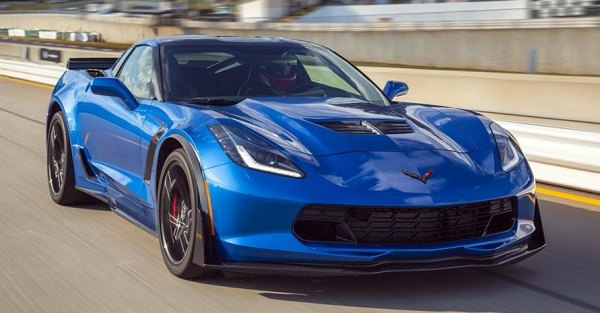
|
I don’t quite understand
why Chevrolet calls this Z06. Considering its supercharged engine, its
weight (almost 200 kg more than the last Z06), its performance level as
well as its relatively good road manner, it should have been the
logical successor
of ZR1. The only reason I could think of is that the ZR1 label could be
reserved for another application – have you heard the rumor about a
mid-engined super Vette? If true, that must be the most exciting news
about American sports car industry. Right now, however, the new Z06
should give us plenty of excitement. Think about 650 horsepower and 650
pound-foot of torque, 0-60 mph sprint in not much over 3 seconds and a
top speed of up to 195 mph. That’s the performance level of Porsche 911
Turbo
S, yet a fully loaded Z06 costs just over US$100,000 or half the price
of Porsche.
Yes, the top Corvette has always been known for superior bang for the
buck, but the latest one adds an extra layer of sophistication. Take
the new LT4 engine for example, it is a development from the LT1 of
standard Corvette. It has modern features that you wouldn't believe,
such as direct injection,
variable cam phasing (on its sole camshaft) and Active Fuel Management
(i.e. cylinder deactivation) thus fuel economy is greatly improved.
Then it
is enhanced with stronger cylinder heads, titanium intake valves,
forged pistons, machined con-rods, stainless steel exhaust headers and
dry-sump lubrication. Inside the V-valley is filled with an Eaton R1740
TVS supercharger. Its smaller and shorter rotors pump out 1740 c.c. of
air every revolution, smaller than the 2300 c.c. on the late ZR1, but
by raising its maximum rev from 15,000 to 20,000 rpm, the amount of
airflow is actually the same. Of course, the smaller rotors enable
quicker response and waste less energy on friction at light load. The
higher, 10.0:1 compression ratio enabled by direct injection also
enhances torque output at low revs. The supercharger and its integrated
intercooler add just 25 mm height above the engine.
Predictably, the car has a power dome on the bonnet to accommodate the
taller engine. It incorporates ventilation lourvers to release hot air
from the engine compartment and contribute to downforce. Speaking of
aerodynamics, the Z06 looks almost like a race car, especially with the
Z07 track package. Its front splitter protrudes aggressively from the
air dam and incorporates vertical winglets at either side. This is
matched with massive side skirts. Brake cooling ducts are opened on the
front mesh grille as well as just before the rear wheels. Larger side
vents are opened behind the front wheels. At the back, the track
package adds a larger tail spoiler whose center section is see-through
(mind you, top speed drops to 186 mph with this package). The aero kits
are all made of carbon-fiber.
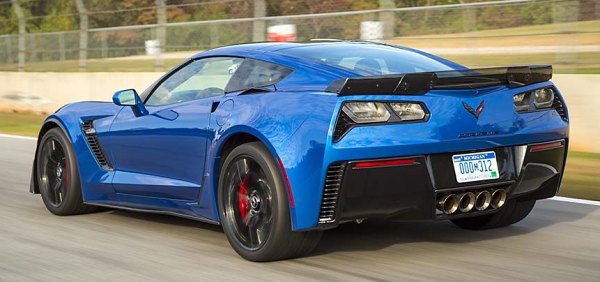
|
The mostly glass-fiber body work is supplemented with
carbon-fiber bonnet and roof. To accommodate the massive, 285/30ZR19
and 335/25ZR20 Michelin Pilot Super Sport rubbers, the front and rear
fenders
have been widened by 56 mm and 80 mm respectively. The aluminum chassis
of C7 is already very stiff, so modification is limited to a
carbon-fiber torque tube. Compared with the old Z06, its rigidity is
upped by a massive 60 percent. This provides a solid foundation for the
double-wishbone suspensions, which accept sportier calibration than the
standard Corvette, of course. The magnetic adaptive dampers of C7 are
another significant upgrade in the view of control and ride quality.
The rear-mounted transmission is either the Stingray's 7-speed manual
with rev-matching
capability or a new GM 8-speed automatic. It might sound
odd for such a track-oriented car to opt for a torque-converter auto,
but GM claims its upshift under wide open throttle is faster than the
PDK box of Porsche 911 Turbo. Moreover, with the help of launch control
it can out-accelerate the 7-speed manual from 0-60 mph. The Stingray's
optional electronic-controlled LSD is made standard on the Z06 to deal
with the extra power and contain oversteer.
Nevertheless, all these sophistications add weight. The Z06
weighs just over 1600 kg, not as much as a Nissan GT-R, but it is 83 kg
heavier than the old ZR1. This explains why most American magazines
failed to improve on the previous straight line performance figures.
Besides, the new car with its downforce-oriented aerodynamics fails to
match the old car's 205 mph top
speed. No wonder GM refuses to badge it as ZR1.
However, with Z07 package equipped, the new car is unquestionably
faster
on a race track. This package adds not only downforce but also Brembo
carbon-ceramic
brakes, 35-percent stiffer suspension and semi-slick Michelin Pilot
Sport Cup 2 rubbers. On dry surfaces, it could generate an astonishing
1.2 g of grip! Such an unshakable roadholding is perhaps the most
impressive aspect of the Z06.

|
On the road, the new Z06 is bit unexpected. You might expect
the driving experience to be dominated by the supercharged V8.
Yes, it is very powerful. It produces mountains of torque as soon as
you floor down the gas pedal. Its sonorous soundtrack is quite
addictive, too, with no traces of supercharger whine. However, the new
engine feels no more special than that of the last ZR1. It is just as
good as expected for its kind. If you chase for the last word of
excitement, a high-revving V10 or V12 would be a better bet. In
contrast, the 7-speed manual is
surprisingly refined. Its clutch take-up is smooth and linear
considering the amount of torque it has to deal with. Its
gearchange is no longer clunky. The rev-matching function speeds up the
gearchange and makes it far more engaging. It is so satisfying to use
that you can easily forget the performance edge of the
alternative 8-speed auto.
Another surprise is the chassis. Apart from strong roadholding, it is
quite well balanced, unlike the old ZR1 which had its chassis
easily overwhelmed by its tremendous power. Thanks to the improved
static balance
(now 50:50 instead of 52:48), stiffer chassis and active differential,
the new Z06 puts down power more efficiently, contains wheel spin and
slide a lot better and steers more accurately. As a result, you can
push it much
harder in fast bends. For a conventional front-engined rear-drive
sports car, its handling is remarkable, if outstanding is reserved for
Ferrari F12 or Aston Martin V12 Vantage S. Of course, mid or
rear-engine cars like 911s or 458 can always find more traction and
sharper steering. The Z06' Cup 2 rear rubbers are massive and
super-sticky,
but they have less weight to act on and far more torque to deal with.
This means, if you are hard on throttle in corner exit, it will still
slide more easily than most European rivals.
Moreover, once it has exceeded the limit of adhesion, it breaks away
more abruptly than those cars. Admittedly, you do need to push really
hard to see the tricky side of its handling. On public roads, you will
be just shocked by its strong roadholding and the stopping power of its
ceramic brakes.
The Corvette’s steering is quite good for an electric-assisted rack, if
not
ultimately as good as those of Porsche GT3, Aston Martin or Ferrari.
You
can also criticize its relatively low-rent interior or creaks of its
plastic body panels. However, for the price it asks and the performance
it delivers, these compromises are understandable. Moreover, this
car serves remarkably well as a daily companion, offering good ride
quality, all kinds of creature comforts, a removable roof and a big
boot. A mid-engined super Corvette will make better use of the
tremendous power, but right now, the Z06 is the King of Corvette as
well as American sports cars.
|
Verdict:     |
Published
on 20
Oct 2016
|
All rights reserved.
|
|
Corvette Grand Sport
|
|
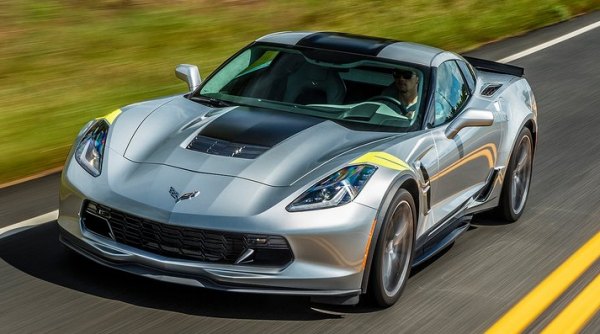
|
Basically, Grand Sport is
the track-oriented version of Corvette. It keeps the standard car’s
460-hp V8, which is a slight disappointment considering what Porsche
has done to the engine of GT3 RS. Instead of powertrain, work was
concentrated on aero, suspension, brakes and tires. The Corvette line
is already served with a large pool of performance options. Grand Sport
makes use
of them to improve its handling. These include the standard
fitment of electronic LSD, magnetic ride adaptive dampers, larger
Brembo brakes and a set of wider tires coming from the mighty Z06, i.e.
285/30ZR19 up front and 335/25ZR20 at the rear. These rubbers look
oversized for the power they have to handle, but they do enable the car
to corner at 1.05g. To accommodate them, the Grand Sport needs the
flared wheel arches of Z06, so it looks pretty aggressive.
If you buy a Grand Sport, you would be foolish to forgo the optional
Z07 package, as it adds carbon-ceramic brakes and stickier Michelin PS
Cup
2 tires (instead of PSS). The powerful brakes shorten stopping distance
considerably yet they never fade. However, the shortlived,
track-oriented tires have even more influence to performance, because
they lift the lateral grip to an eye-popping 1.18g, making the car
corner significantly faster, resisting understeer and oversteer as if
running on
rails. They also improve rear-end traction hence standing-start
acceleration
slightly. On the downside, like all track tires, they need heat and a
dry surface to
build up adhesion. On a cold or wet day, the rear tires struggle to put
down the power thus you have to turn up the traction management to
avoid spin or sideway.
Another must-have option is the stage-2 aero kits, which is the middle
choice on Z06. It slows the car’s terminal speed to 175 mph but
produces the downforce necessary to keep the car stable in fast
corners.
The
Grand Sport is not cheap. It starts at $66K, $10K more than a Stingray.
With the aforementioned options it
is already $77K. When fully optioned it costs
nearly as
much as a Z06, which
offers a lot more power and drama. If you
rarely visit tracks, it would be meaningless to buy a
Grand Sport, because on public roads you don't have the speed and space
to access its deep reserves of grip. Yes, it doesn't sacrifice much in
ride or creature comfort, thanks to the magnetic dampers and
feature-rich cabin, but it doesn't show any advantages over the
standard
Corvette either.
As a track-oriented special, it still lacks a couple of things to
impress. Firstly, more
power and an angrier engine noise could have given it a distinctive
character. Secondly, a
thorough weight reduction could have made it feel more agile and faster
still, not just all about roadholding. As it doesn't have both, it
fails to
repeat the magic of Porsche 911 GT3 RS. In short, it needs
more
Renn and less Grand.
|
Verdict:     |
Published
on 3
May 2018
|
All rights reserved.
|
|
Corvette ZR1
|
|
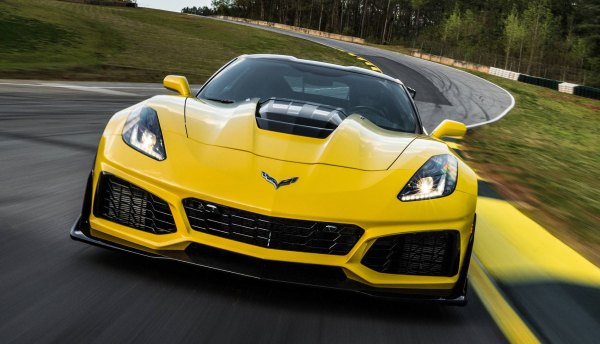
|
|
The
power bulge moves under every prod of throttle, which must be
interesting to view from the driver seat...
|
|
It is an open secret that
the next generation Corvette will be converted to mid-engine. Before
that historic change happens, the front-engined C7 will bow out on a
high with its ultimate version, ZR1. Yes, this is the most powerful and
fastest ever Corvette in its 65-years history. Headline figures are 755
hp and 715 lbft of torque, exceeding the already mighty Z06 by some 105
horsepower and 65 pound-foot, respectively. It will top out at 212 mph
and do 0-60 sprint under 3 seconds, matching a McLaren 720S! Needless
to say, it is the most
expensive Corvette to date, too, ranging from $120,000 to $140,000
depending on options, well over the $85K Z06, the $66K Grand Sport and
the $56K base Corvette. However, unlike the Z06, it will be bounded in
the North America and skip the European market.
The new ZR1 can be easily distinguished from Z06 by its huge power
bulge on the bonnet, which reminds us the baddest big-block Corvettes
in the 1960s and 70s. It is to accommodate the larger capacity
supercharger and intercoolers, which is 75mm taller. Made of
carbon-fiber, the power bulge is actually the intercooler cover thus it
is separated from the carbon-fiber bonnet. In driving, it moves under
every prod of throttle, which must be interesting to view from the
driver seat. The nose of the car is obviously dominated by massive
intakes, because this car has as many as 13 heat exchangers, including
4 new radiators. The standard aero package is also a little more
aggressive than the Z06's, including large front splitters and a bigger
rear spoiler. It generates 70 percent more downforce than the standard
Z06.
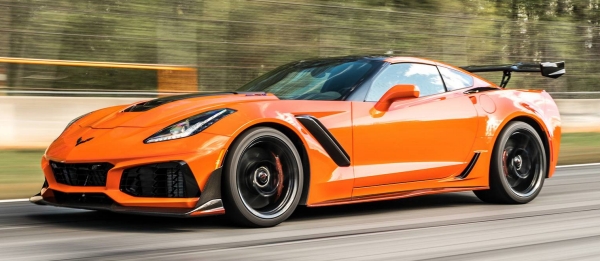
|
|
212
mph and 0-60 under 3 seconds... it is as fast as a McLaren 720S !
|
|
However, should you want the ultimate ZR1 for track abuse, you must
take the ZTK package. It adds vertical fins to the sides of front
splitter and a huge, high-mounted rear wing more akin to a race car.
The rear wing's angle is manually adjustable. At the highest angle the
car generates 430kg of downforce at top speed, 60 percent more than the
Z06 fitted with aero kits. Scale back to the lowest angle and you can
achieve 202 mph flat out, 10 mph lower than the standard package but
still comfortably faster than the Z06. Nevertheless, you have to adjust
it outside the car with tools, as GM thought an active rear wing too
complicated and costly to develop for a bow-out model. The huge rear
wing is fixed to the chassis structure thus it blocks the access to
luggage compartment considerably. Apparently, the drivers of ZR1 are
unlikely to play golf regularly.
Apart from aero kits, the ZTK package also brings stickier Michelin
Pilot Sport Cup 2 tires (instead of Pilot Super Sport) and specific
tuning to the Magnetic Ride Control adaptive dampers. Brembo
carbon-ceramic brakes, however, is standard with or without the ZTK
pack. They
are no larger than the ones available to Z06, but fitted with higher
performance pads. Otherwise, the chassis is largely carried over from
the Z06.
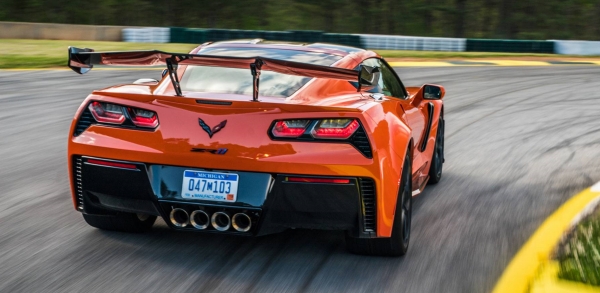
|
|
ZTK
package generates lots of downforce to lift cornering prowess.
|
|
The engine is still that 6.2-liter supercharged pushrod V8, but it gets
a new codename LT5 accompanied with various modifications, most notably
a 2.65-liter Eaton TVS supercharger (up from 1.74-liter) and
double-size intercoolers. Although the blower spins slower than before,
down from 20,000 to just under 16,000 rpm, the amount of air it
supplies is still increased, so maximum boost pressure is lifted from
0.65 to 0.96 bar. The small-block V8 also has its direct injection
system added with supplementary port injection. Its crankshaft is
strengthened to take on the increased output. Cylinder deactivation
mechanism has been ditched to save weight (it can’t escape from gas
guzzler tax anyway). The new exhaust has mechanical instead of
electronic-controlled bypass valves for angrier noises. The latter is
made possible by forgoing European type approval, similar to the case
of the rigid power bulge which is impossible to pass European
pedestrian safety law. Power and torque are released at 6300 rpm and
4400 rpm, respectively. The 7-speed manual or 8-speed automatic
transmission are carried over intact from the Z06.
GM wants the ZR1 to maintain good road manners, so its suspension is
not set overly sporty. The interior is by no means stripped-out,
leaving only the carbon-fiber trims and sport bucket seats to
distinguish from lesser models. Kerb weight is quoted to be 1615 kg,
marginally more than the Z06. This is down to not only the deletion of
cylinder deactivation but also the use of more carbon-fiber in its body
work, such as bonnet, roof, tailgate, fenders, rear quarter panels and
most of the aero stuffs. Weight distribution has not been revealed, but
the engine is heavier thus it is the only C7 having a front-biased
weight distribution. It might be the fastest and
maddest Corvette ever, but can it be the sweetest to drive? Let’s see...
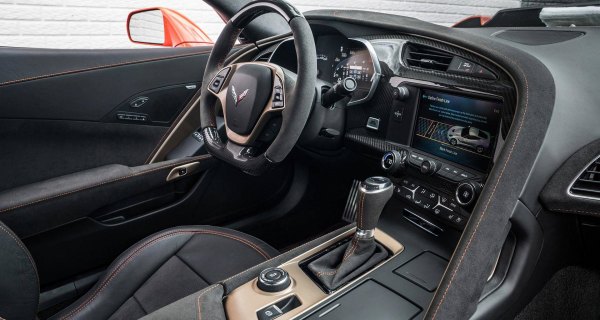
|
|
In
daily commute the ZR1 displays a road manner as good as lesser
Corvettes...
|
|
On the Road
First to be noted: despite the jaw-dropping numbers and maddest looks,
the ZR1 displays a road manner as good as the Z06 or Grand Sport, at
least when you are driving it leisurely. Admittedly, the car’s
suspension setup and tires are not much different from the lesser
models, and the cockpit is not stripped out by any means. The magnetic
adjustable dampers continue to deliver a pretty comfortable ride in the
softest setting. While road noise is never the strength of Corvette,
the mega V8 is surprisingly calm in touring mode. Its power delivery is
also
linear enough for day to day commute. The only problem is reduced
outward visibility, blame to the big power bulge and rear wing.
However, it is a compromise enthusiasts happy to tolerate.
Plant the throttle pedal, and the supercharged V8 responds immediately
with vast of thrust. 715 pound-foot of torque is no joking. It makes
the ZR1 feels insanely fast, more so than the Z06. Even the traction
control struggles to lay down the power smoothly in launch. This engine
will spin the rear tires up to 60 mph, so the promised 2.85 seconds
will need repeated attempt. At full throttle the exhaust roars so loud
that few road cars could match, Jaguar F-Type SVR included. Not just
volume, it excels in sound quality as well, thanks to a glorious bass
that is so different from the high pitch scream of European engines.
The 8-speed automatic is the choice for fastest acceleration and even
lap time, but subjectively it is no match for the 7-speed manual with
automatic rev-match. While the manual’s shift quality is no
Porsche-grade, it is decent enough and far more engaging than the
automatic. The latter shifts smoothly, but downshift is sometimes
hesitant, interrupting the rhythm of spirited driving.
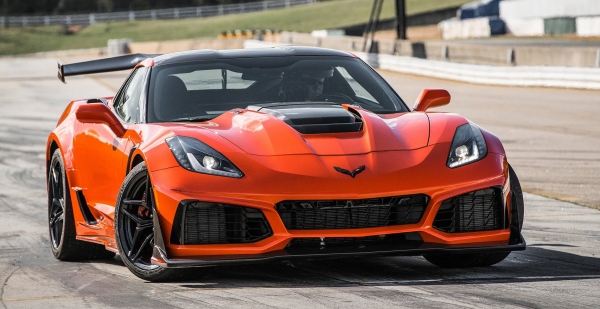 |
|
The
ZR1 is the ultimate Corvette, so ultimate that we finally found its
ultimate limits.
|
|
Compared with Z06, the chassis of ZR1 excels in two areas: braking and
down force. Its carbon brakes are not only powerful but are also tuned
to deliver perfect pedal feel, giving strong confidence to haul down
the seriously fast machine. Once you are up to speed, the down force
generated by ZTK aero package presses the car to the ground and allows
it to attack corner much faster than Z06. It is therefore a much better
performer on track. In fact, the ZR1 laps Virginia Raceway even faster
than the Ford GT, a mid-engined supercar purposely designed for racing!
In slower, tighter corners, little down force is available and the ZR1
becomes trickier to handle. You have to be patient with throttle,
otherwise the immense grunt could easily spin the rear rubbers.
Although the traction control keeps the breakaway relatively benign,
you can feel the ZR1 has an engine overwhelming its chassis. Every prod
of throttle will unsettle its balance, lighten the nose and cause the
electronics to intervene. Switching off traction control is not a great
idea. A Porsche 911 GT3 or GT3 RS is more coherent, precise, adjustable
and you can extract its full potential without mercy, thanks to better
traction, balance and steering. In comparison, the ZR1 feels more like
a modern hot rod. Its power has become so fearsome that its chassis
cannot keep up with. Fast though it is, it does not satisfy its driver
as much as the very best European machines.
No wonder it is time to abandon its traditional formula and turn to
mid-engine. The ZR1 is the ultimate Corvette as we know, so ultimate
that we finally find its upper limits.
|
Verdict:     |
|